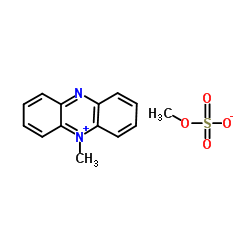Pyocyanine

Pyocyanine structure
|
Common Name | Pyocyanine | ||
|---|---|---|---|---|
| CAS Number | 85-66-5 | Molecular Weight | 210.231 | |
| Density | 1.24g/cm3 | Boiling Point | 403.3ºC at 760 mmHg | |
| Molecular Formula | C13H10N2O | Melting Point | N/A | |
| MSDS | Chinese USA | Flash Point | 197.7ºC | |
| Symbol |


GHS05, GHS07 |
Signal Word | Danger | |
Use of PyocyaninePyocyanin (Pyocyanine) is a phenazine that is a toxic, quorum sensing (QS)-controlled metabolite produced by P. aeruginosa. Pyocyanin is a redox-active compound and promotes the generation of reactive oxygen species (ROS). Pyocyanin also possesses antibacterial properties and increases fitness in competition with other bacterial species[1]. |
| Name | 5-methylphenazin-1-one |
|---|---|
| Synonym | More Synonyms |
| Description | Pyocyanin (Pyocyanine) is a phenazine that is a toxic, quorum sensing (QS)-controlled metabolite produced by P. aeruginosa. Pyocyanin is a redox-active compound and promotes the generation of reactive oxygen species (ROS). Pyocyanin also possesses antibacterial properties and increases fitness in competition with other bacterial species[1]. |
|---|---|
| Related Catalog | |
| References |
| Density | 1.24g/cm3 |
|---|---|
| Boiling Point | 403.3ºC at 760 mmHg |
| Molecular Formula | C13H10N2O |
| Molecular Weight | 210.231 |
| Flash Point | 197.7ºC |
| Exact Mass | 210.079315 |
| PSA | 39.83000 |
| LogP | 2.35630 |
| Index of Refraction | 1.665 |
| Symbol |


GHS05, GHS07 |
|---|---|
| Signal Word | Danger |
| Hazard Statements | H302-H318 |
| Precautionary Statements | P280-P305 + P351 + P338 |
| RIDADR | NONH for all modes of transport |
| HS Code | 2933990090 |
|
~51% 
Pyocyanine CAS#:85-66-5 |
| Literature: Organic and Biomolecular Chemistry, , vol. 12, # 6 p. 881 - 886 |
| Precursor 1 | |
|---|---|
| DownStream 0 | |
| HS Code | 2933990090 |
|---|---|
| Summary | 2933990090. heterocyclic compounds with nitrogen hetero-atom(s) only. VAT:17.0%. Tax rebate rate:13.0%. . MFN tariff:6.5%. General tariff:20.0% |
|
Oxidants induce a corticosteroid-insensitive phosphorylation of histone 3 at serine 10 in monocytes.
PLoS ONE 10(4) , e0124961, (2015) Oxidative stress enhances inflammation and reduces the effectiveness of corticosteroids, but the inflammatory signalling pathways induced by oxidants remain ill-defined. Phosphorylation of histone 3 a... |
|
|
Virulence Factors of Pseudomonas aeruginosa Induce Both the Unfolded Protein and Integrated Stress Responses in Airway Epithelial Cells.
PLoS Pathog. 11 , e1004946, (2015) Pseudomonas aeruginosa infection can be disastrous in chronic lung diseases such as cystic fibrosis and chronic obstructive pulmonary disease. Its toxic effects are largely mediated by secreted virule... |
|
|
The impact of plant volatiles on bacterial quorum sensing.
Lett. Appl. Microbiol. 60(1) , 8-19, (2015) Studies describing the use of essential oil constituents as antimicrobial agents have steadily increased; however, some phyto-constituents are often overlooked due to unfavourable minimum inhibitory c... |
| Sanasin |
| Phenazinium, 1-hydroxy-5-methyl-, inner salt |
| 5-methyl-5H-phenazin-1-one |
| Pyocyanin |
| 1-hydroxy-5-methyl-phenazinium betaine |
| 5-Methylphenazin-5-ium-1-olate |
| 5-methylphenazin-1(5H)-one |
| Sanazin |
| 1(5H)-phenazinone, 5-methyl- |
| Pyocyanine |
| 1-hydroxy-5-methylphenazine |
| Pyrocyanine |
